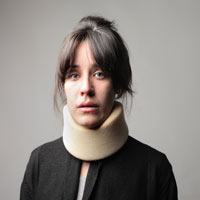Recovering from Whiplash
December 19, 2018 Imagine you are stopped at a red light. Suddenly, you hear tires screeching behind you. You look in the rear-view mirror, but before you can get out of the way a car comes plowing into the rear end of your vehicle. The impact from this, or any car accident, is frightening.
Imagine you are stopped at a red light. Suddenly, you hear tires screeching behind you. You look in the rear-view mirror, but before you can get out of the way a car comes plowing into the rear end of your vehicle. The impact from this, or any car accident, is frightening.
Even though you may be wearing your seatbelt when you are struck, and even though you may not feel any pain right away, you could wind up with whiplash, or a range of other injuries.
Hours later, you may feel extremely stiff, and the pain could seem unbearable. That is because your body releases adrenaline and cortisol hormones immediately after an injury. These mask the pain, giving you the ability to respond in an emergency. But when these hormones wear off, the pain sets in, and it can get much, much worse.
Whiplash injuries often involve delicate soft tissue, such as muscles and ligaments. If the injury is not treated immediately, your usual daily activities will likely aggravate the injury and make it worse, to the point where it can become debilitating.
What Causes Whiplash?
Whiplash occurs when you are struck forcefully, causing rapid back-and-forth movement of your neck. It is called “whiplash” because it is like the cracking of a whip.
This type of motion can cause many kinds of injuries, which are generally known as whiplash-associated disorder (WAD). Being rear-ended by another vehicle is maybe the most common cause of whiplash, but there are others.
What You Should Do After a Whiplash Injury
First, see a doctor. A doctor can more accurately evaluate whether your injury is whiplash, or something else. Diagnosing whiplash is not done with an x-ray or any other type of diagnostic tool. Your doctor will assess the type of pain you are experiencing, and what movements create pain.
Your doctor may care for your whiplash injury with a variety of treatments, including:
- Pain medication and NSAIDs
- Epidural or other injections to block pain, so that tissues can heal
- Massage therapy
- Physical therapy
- Strengthening and stretching exercises
- Chiropractic care
- A neck brace or soft cervical collar
After you have seen a doctor, there are things you can do to lessen your pain and discomfort at home. These include:
- Icing the affected are during the first 24-hour period only
- Avoid physical activities that could potentially aggravate your injury
- Use over-the-counter pain medications, after checking with your physician
- Wear a neck collar, rolled-towel, or neck pillow while sleeping to minimize movement
Baltimore Car Accident Lawyers at LeViness, Tolzman & Hamilton Advocate for Victims of a Whiplash Injury
After an accident, you are thrown into a tumultuous period of visiting doctors, getting treatment for your injuries, dealing with insurance paperwork, and trying to recover from your injury, of course. If you have been injured in a car accident, the Baltimore car accident lawyers at LeViness, Tolzman & Hamilton can help to make the situation much easier, and far more stress-free. We will work to build a strong case so that you can get the financial compensation you need and deserve at a challenging time. To schedule a free, confidential consultation, call us today at 800-547-4LAW (4529) or contact us online.
Our offices are located in Baltimore, Columbia, Glen Burnie, and Towson, allowing us to represent car accident victims in Maryland, including those in Anne Arundel County, Baltimore County, Carroll County, Harford County, Howard County, Montgomery County, Maryland’s Western Counties, Prince George’s County, Queen Anne’s County, Southern Maryland, and the Eastern Shore, as well as the communities of Catonsville, Essex, Halethorpe, Middle River, Rosedale, Gwynn Oak, Brooklandville, Dundalk, Pikesville, Nottingham, Windsor Mill, Lutherville, Timonium, Sparrows Point, Ridgewood, and Elkridge.






